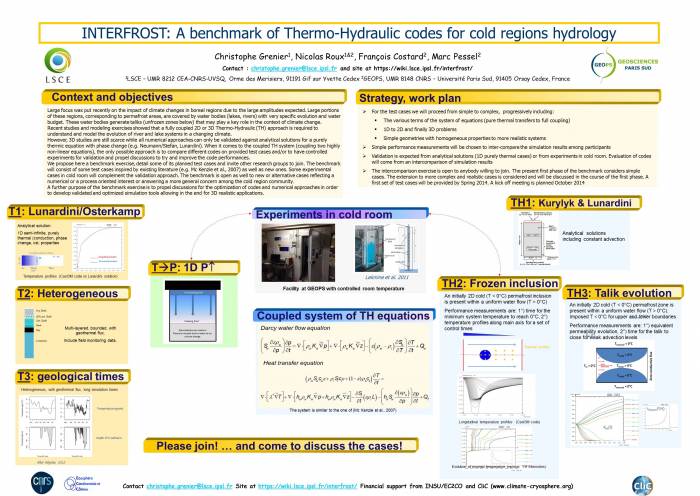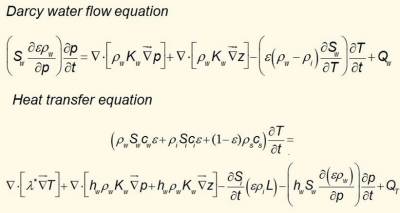An overview of the test cases considered so far is provided on an actualized version of a poster formerly presented at EGU 2014, www.egu2014.eu (please click to enlarge):
The poster is available as well for downloading as pdf file poster_benchmark_egu_2014_actualise.pdf
Set of equations
Baseline for the validation & evaluation of codes
The validation of the codes for the set of coupled TH equations will rely on three main types of action:
- Comparison with analytical solutions: 1D purely heat transfer case by conduction with phase change.
- Inter-comparison of codes for more complex test cases (1D & 2D, purely heat transfer to TH coupling). Data spread sheets are provided as well as performance measures allowing for simulation results comparison among participating codes.
- Confrontation with experimental results: some test cases were designed to be run in the laboratory in the framework of a collaboration with GEOPS laboratory (Univ. PARIS SUD, Orsay) equipped with a cold room facility. In the absence of analytical solutions, the experiment is a kind of ultimate solution. The difficulties associated with experimental setups adapted to coupled TH processes are large. Obtain an initial contrasted initial thermal field and control that the experiment box is impermeable and that the leakage of heat is controlled is a major challenge.
Even in the case of lab experiments where the maximum control on the experimental conditions and medium properties is researched and expected, some porous medium inhomogeneities, 3D effects, side leakages or difficulties in measuring some properties or parameters are probable. The “validation” of codes against such laboratory results will probably not be “the” ultimate solution one would wish. The confrontation between numerical and analogical simulation will thus require some level of calibration. This same difficulty is greatly amplified when considering a code validation relying on the confrontation with data issued from field monitoring. Such data corresponds to real world conditions that are more complex that lab experiments (e.g. multi-process, porous medium heterogeneities). The use of such field monitoring datasets is not contemplated for the present initial stand of the benchmark project. A longer perspective of the benchmark project is to propel the development of codes to deal with real world complex cases. More complex lab experiments and field monitoring will be included later on.
Detailed presentation of the test cases
A step by step procedure is designed to proceed from simple test cases to the full coupled TH system:
- T1, T2, T3: 1D pure heat transfer test cases, including the case with analytical solution
- T→P: 1D heat transfer with pressure increase (no water flow)
- TH1, heat transfer with constant advection (analytical solution). TH2 and TH3: Coupled TH transfers
An experiment in cold room associated with Case TH1 is ongoing.
Case T1 1D semi-infinite heat conduction case with phase change leading to an analytical expression (Lunardini solution).
Case T2 1D vertical soil column with porous medium properties and geothermal flux, pure conduction with phase change
Case T3 Similar case for geological time scale and the evolution of permafrost depths
Case T->P Pressure increase associated with freezing front progression in volume controlled fully saturated porous medium
Case TH1 1D heat transfer with conduction, phase change and advection with constant velocity (analytical solution)
Case TH2 Initial frozen inclusion evolution (full coupling with inflowing water)
Case TH3 Closure / Opening of a talik due to challenging inflowing water and negative temperatures imposed on lateral sides

